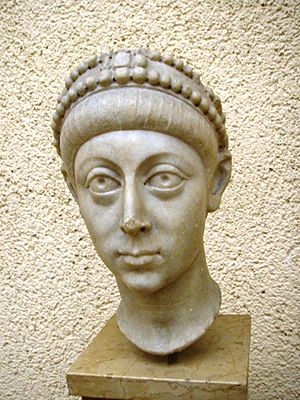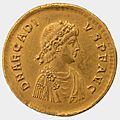Arcadius facts for kids
Quick facts for kids Arcadius |
|
|---|---|

A statue of Arcadius from the Istanbul Archaeology Museum. It shows a mix of old Roman art styles and new ones.
|
|
| Roman emperor in the East | |
| Augustus | 16 January 383 – 1 May 408 (senior from 17 January 395) |
| Predecessor | Theodosius I |
| Successor | Theodosius II |
| Co-rulers | Theodosius I (383–395) Honorius (West, 393–408) Theodosius II (402–408) |
| Born | c. 377 Hispania |
| Died | 1 May 408 (aged c. 31) |
| Burial | Church of the Holy Apostles, Constantinople (now Istanbul, Turkey) |
| Spouse | Aelia Eudoxia |
| Issue |
|
| Dynasty | Theodosian |
| Father | Theodosius I |
| Mother | Aelia Flaccilla |
| Religion | Nicene Christianity |
Arcadius (born around 377 – died May 1, 408) was a Roman emperor who ruled from 383 to 408. He was the oldest son of Emperor Theodosius I and his first wife, Aelia Flaccilla. His brother was Honorius. When their father died in 395, Arcadius became the ruler of the eastern part of the Roman Empire, while Honorius ruled the western part. Arcadius was not a strong ruler himself. His time as emperor was mostly controlled by powerful government officials and his wife, Aelia Eudoxia.
Contents
Becoming Emperor
Early Life and Co-Rulership
Arcadius was born in 377 in Hispania (modern-day Spain). He was the first son of Emperor Theodosius I. On January 16, 383, when Arcadius was just five years old, his father declared him an Augustus. This made him a co-ruler for the eastern half of the Roman Empire. Ten years later, his younger brother Honorius was also made an Augustus for the western half. Arcadius spent his early years learning from famous teachers, including Themistius and Arsenius Zonaras.
Taking the Throne
Both Arcadius and Honorius were young and didn't have much experience when their father, Theodosius I, died in 395. Arcadius was only 17. He quickly came under the influence of a powerful official named Rufinus. Rufinus wanted his own daughter to marry Arcadius to gain more power.
However, another official, a eunuch named Eutropius, had other plans. He showed Arcadius a picture of Aelia Eudoxia, the daughter of a Frankish general. Arcadius liked what he saw, and Eutropius quickly arranged for them to meet. Arcadius fell in love, and they married on April 27, 395. Rufinus was surprised and angry, as he thought his daughter would be the bride. This event showed how different people at court fought for influence over the young emperor.
Challenges and Advisors
Dealing with Rebellions
One of the first big problems Arcadius faced was a rebellion by the Visigoths in 395. Their leader, Alaric I, saw that the new emperors were young and inexperienced. Alaric marched his army through Macedonia and Thrace, taking valuable goods. The Eastern Roman Empire couldn't do much because most of its army was in Italy with Stilicho, a powerful general who claimed to be the guardian of both emperors.
Stilicho came east to fight Alaric, but Arcadius and Rufinus felt threatened by him. They ordered Stilicho to send his troops back and not come any further. Stilicho obeyed. Rufinus was later killed by Gothic soldiers, possibly on Stilicho's orders and with Eutropius's support. Eutropius and Arcadius's wife, Eudoxia, then became the main advisors to the emperor.
Eutropius gained a lot of power. He even became a consul, which was a very high position, but many people were upset because he was a eunuch and a former slave. In 398, Eutropius led a successful military campaign against the Huns. However, his power didn't last. In 399, the Ostrogoths in Asia Minor rebelled and demanded that Eutropius be removed. Arcadius, influenced by Eudoxia, agreed. Eutropius was exiled and later executed.
The Rise and Fall of Gainas
After Eutropius was gone, another powerful general named Gainas tried to take control. He joined the rebel Ostrogoths and forced Arcadius to give him important military titles. Gainas also demanded that an Arian church be built in Constantinople for his Gothic soldiers. However, Arcadius refused, following the advice of John Chrysostom, the Archbishop of Constantinople.
By July 400, Gainas's actions had made many people in Constantinople angry. Riots broke out, and about 7,000 Goths in the city were killed. Gainas then left the city with his soldiers and rebelled against Arcadius. He tried to cross into Asia, but another Gothic general, Fravitta, defeated him. Gainas fled but was eventually killed by Uldin the Hun.
Conflicts with John Chrysostom
With Gainas defeated, the next big conflict was between Empress Eudoxia and Archbishop John Chrysostom. Chrysostom was a strict and simple man who often criticized people who showed off their wealth, especially women. Eudoxia felt that his sermons were aimed at her.
Tensions grew, and in 401, Chrysostom preached a sermon where he openly compared Eudoxia to Jezebel, a wicked queen from the Bible. Eudoxia fought back, supporting a bishop who was against Chrysostom. Because Chrysostom was very popular, riots broke out in the capital. Arcadius and Eudoxia had to back down and ask Chrysostom to return.
In 403, Eudoxia found another chance to attack the Archbishop. She supported another bishop who accused Chrysostom of heresy. Arcadius at first supported Chrysostom, but when the Archbishop refused to attend the trial, Arcadius changed his mind. Chrysostom was removed from his position and sent away. However, people rioted again, even threatening to burn the imperial palace. An earthquake happened the night of his arrest, which Eudoxia saw as a sign of God's anger. She asked Arcadius to bring John back.
The peace didn't last long. In September 403, a silver statue of Eudoxia was put up near the main church, the Magna Ecclesia. Chrysostom, who was holding a church service, loudly criticized the noisy dedication ceremony. He compared Eudoxia to Herodias, who asked for John the Baptist's head. This time, Arcadius would not ignore the insult to his wife. A new church meeting was called, and Chrysostom was condemned again. Arcadius finally forced the Archbishop to leave on June 20, 404, sending him far away to Abkhazia. Eudoxia did not get to enjoy her victory for long; she died later that year.
Later Years and Death
After Eudoxia died, Arcadius once again came under the influence of a powerful court member, this time a skilled official named Anthemius. Anthemius ruled in Arcadius's name for the last four years of his reign. He tried to fix the problems caused by previous advisors and even tried to make peace with Stilicho in the West.
Arcadius died on May 1, 408. His young son, Theodosius II, became the next emperor. Arcadius was buried in the Church of the Holy Apostles in Constantinople, in a special stone coffin.
Arcadius's Legacy
Many historians have seen Arcadius as a weak emperor who was easily controlled by others. His reign was marked by struggles for power among different groups at court, especially between those who wanted to limit the influence of non-Roman (barbarian) soldiers like the Goths.
Arcadius himself was more interested in being a devout Christian than in military or political matters. He promoted the idea of imperial victory through his piety, rather than through military achievements. During his reign, there was a strong push to completely end paganism. On July 13, 399, Arcadius ordered that all remaining non-Christian temples should be destroyed.
A new public square, called the Forum of Arcadius, was built in Constantinople in his name. A tall column was started there to celebrate his "victory" over Gainas, though it was finished after Arcadius's death. A marble statue head of Arcadius, found in Istanbul, shows him wearing a royal headband with pearls.
Arcadius had four children with Eudoxia: three daughters named Pulcheria, Arcadia, and Marina, and one son, Theodosius, who would become Emperor Theodosius II.
Images for kids
See also
 In Spanish: Arcadio para niños
In Spanish: Arcadio para niños



